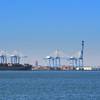Explorer of the Seas was delivered by Kvaerner Masa-Yards' Turku shipyard on September 28 to Royal Caribbean in time for its dedication and naming ceremony, which was held in New York on October 21. The second member of RCCL's Project Eagle series, the vessel follows the successful delivery of the class' premiere vessel, Voyager of the Seas, which was delivered last October.
Known as a member of the largest class of vessels in the world, Explorer has a gross tonnage of 137,300 and is able to hold 3,840 passengers. Measuring 1,020 ft. (311.1 m), the vessel boasts a breadth of 126 ft. (38.6 m) at waterline level and holds a height of 237 ft. (72.3 m) from keel to the top of the funnel. The vessel's Post-Panamax size allows for the option of unique design features and interior solutions.
Upon its departure from New York, the vessel will steam south towards its homeport in Miami, Fla. to begin its first run of seven-day cruises to the Eastern Caribbean.
Explorer's production process commenced in June 1998 with its dock out occurring in November 1999. Successful sea trials took place in June of this year. Classified by DNV, the vessel was constructed by the yard in conjunction with a variety of turnkey suppliers. Design teams and architects that contributed to the project are comprised of the Norwegian firm Nijal R. Eide; Howard Snoweiss Design Group; Tom Graboski & Associates; Tillberg Design and Wilson Butler Lodge.
The vessel's power encompasses three azimuthing electric 14 MW Azipod units through 360-degrees, which was developed jointly by Kvaerner and ABB.
Improving the vessel's fuel efficiency, this podded electric propulsion system incorporates an electric AC motor located inside the propeller pod, which directly drives a fixed-pitch propeller.
So that it is able to manage four knots side winds, there are four 3 MW tunnel thrusters in the bow in addition to the Azipod units in the stern. Sea trials proved that the vessel can move sideways with a speed of three knots.
Featured videos

Tracking Foreign Vessels Working in the U.S. Jones Act Market

Inside the Electrified Truckable Tug

Inmarsat Enhances Service to Drive Digitalization
Subscribe for
Maritime Reporter E-News
Maritime Reporter E-News is the maritime industry's largest circulation and most authoritative ENews Service, delivered to your Email five times per week









